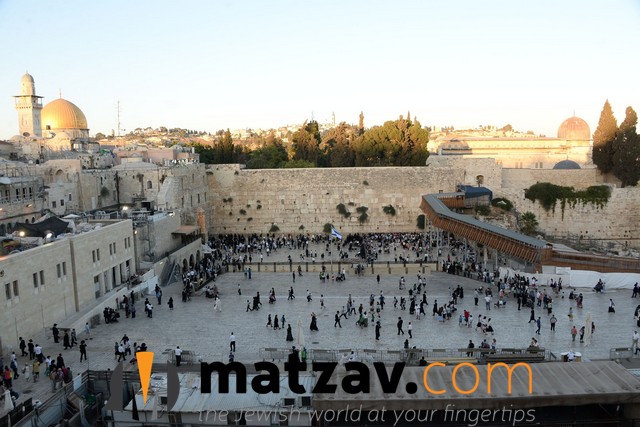
The Old City of Yerushalayim may be a fabulous site to visit, but anyone who has tried getting there with ease has likely failed miserably. And that’s because there is no truly convenient way for most people to reach the area without a great deal of walking or expenditure on a private cab.
Add in the Middle Eastern summer heat or crowds, or both, and you are looking at a fairly wretched experience. This is exactly what the Jerusalem Municipality, the Ministry of Tourism and the Jerusalem Development Authority, along with many residents and tourists, are hoping to change. With growing tourism numbers and even more expected in the coming years, Yerushalayim simply cannot handle great amounts of tourists and the Old City needs a plan. That plan is to build a cable car that starts at the First Station complex just outside the Old City Walls and ends just outside the gate nearest the Western Wall and Temple Mount.
A record-breaking number of tourists—3.6 million—visited Israel in 2017. October 2018 was the best tourism month yet. According to Israel’s Central Bureau of Statistics, approximately 486,000 tourist entries were recorded in October, an all-time monthly record for incoming tourism. 2018 is on track to hit 4 million tourists.
The cable car is expected to span the Hinom Valley, reaching Shaar Tzion and then Shaar Ashpah. Some activists have claimed that the cable car will ruin the skyline of the ancient city and should not pass through the Gey Ben Hinom National Park. They also say the Elad group—the company that runs the City of David archaeological site—will benefit financially from the cable car since the final station will be built on its property. At the same time, Arab residents in eastern Jerusalem have complained that they have not been consulted in the planning process and argue that the construction would displace residents in the predominately Arab neighborhood of Silwan.
Doron Spielman, vice president of the City of David Foundation, refutes these claims. He told JNS that “the planned cable-car project is the initiative of the Yerushalayim Municipality and multiple Israeli government ministries. The City of David welcomes all projects that increase access to the millions of visitors annually—of all faiths and backgrounds—seeking to connect with the historical significance of ancient Jerusalem, including sites throughout the Old City, and the City of David.”
Recently, the cable-car project was submitted to the National Infrastructure Committee, which, in turn, approved for submission the plan to build the cable car. After approval by the committee, the plan will move to the stage in which comments and objections from the district committees and the public are welcome. The National Infrastructure Committee is comprised of government representatives, public representatives and representatives of local authorities who discussed the matter.
Minister of Tourism Yariv Levin said, “We have taken another major step towards approving the cable-car project in Jerusalem. We are spearheading and budgeting the project, which will change the face of Jerusalem, allowing easy and convenient access for tourists and visitors to the Western Wall. The cable car will serve as an exceptional and important tourist attraction.”
According to the tourism ministry, “the cable car is designed to address the problem of congestion and accessibility that exists in the southeastern basin of the Old City, given the significant increase in tourist traffic to Israel in the past two years. The cable car will be part of the city’s public transportation system and will make accessible sites of national, international and tourist importance.”
The ministry claims the cable-car system will have a capacity of 3,000 passengers in each direction during peak time and will be connected to the mass transit system planned in Jerusalem. The cable car provides a unique transportation solution in an area with topographic constraints, limited road infrastructure capacity, and historical and archaeological sites. Unlike other methods, this means of transportation above the ground does not require significant land, nor does it require construction or the expansion of roads.
It is also a “green project” characterized by minimal environmental damage, quiet technology and zero pollution.
‘A project of great importance’
In May, the government approved the bill proposed by Levin to allocate NIS 200 million from the Ministry of Tourism for construction of the cable car. The project will be implemented by the Yerushalayim Development Authority.
According to a press release from the tourism ministry, the cable-car project “is a significant milestone in promoting Jerusalem and strengthening its status as a world tourism capital, in order to significantly increase incoming tourism to the country and strengthen its economy. The cable car, which will also be a unique tourist attraction with views from above Yerushalayim and its unique sites, will also serve to strengthen and develop the night tourism product of the city. …
“The cable car will provide transportation and environmental solutions, and it will make the Old City accessible for people with disabilities. On holidays for the three monotheistic religions, between tens and hundreds of thousands of people visit the Old City. Today, vehicle access for non-residents is prohibited in most parts of the Old City and, therefore, the cable car is defined as a project of great importance to tourism in Yerushalayim.”
Ilanit Melchior, director of the JerusalemYerushalayimDevelopment Authority, told JNS that “the project is moving forward. We are building the cable car.”
(JNS)
{Matzav.com}












The old city can accommodate masses of tourists, except that three quarters of it are OCCUPIED by Palestinians. Take it back, don’t put an ugly cable car there.
Kahana tzodek!
Why not just improve the bus service so people don’t have to wait 45minutes or more for a bus to or from the Kotel?!!!